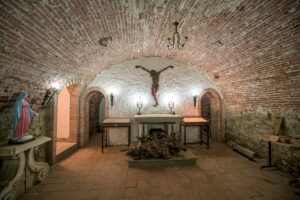Apparently, this territory was not inhabited until about the year 1000. During the 11th century, a Benedictine monastery-or perhaps it would be better to say a hospitale run by the monks arose here? – aimed at being a resting place for pilgrims who intended to arrive in Genoa to embark for Rome or the Holy Land.
The Del Bosco marquises, who had long held some fiefs a little further north, also stretched their hands over these places during the 12th century, where a kind of post station, or perhaps a small fortification, arose, housing some of the marquises’ armies, who were entrusted with the task of guarding the stretch of road and collecting the toll.
Meanwhile, the abundance of water and timber had begun to make Masone the site of steel and non-steel production.
At the end of the thirteenth century, the army of the Republic of Genoa took the small fief, and the nobles of the Superb began to take an interest in this place precisely because of its “industrial” potential.
As early as the late Middle Ages, in fact, Masone became an important production center where raw materials arrived from elsewhere, and from where iron, silk and paper departed. Masone was a fief of many noble Genoese families. Recall Angelo Lomellino who, around the middle of the 14th century, had two ironworks built and encouraged the movement of skilled Lombardian ironworkers.
The former Benedictine monastery also underwent several changes, especially during the 15th century, when it also became a Cistercian monastery for women, only to be abandoned at the end of the century.
By the 1620s, Masone was in the hands of the Spinola family. Marquis Antonio had another castle built, so as to guard the new road that allowed the crossing of the Apennines.
Instead, it was a Grimaldi, in the second half of the same century, who encouraged the construction of a village around the castle, where those who came to Masone to work in the production of iron and charcoal could take up residence. The same nobleman financed the construction of a new church with an adjoining convent intended for Augustinian friars, who would take care of souls in place of the secular clergy.
In the second half of the seventeenth century, however, the local ironworks went into crisis as they could not keep up with evolving technology. Consequently, the number of Masone residents devoted to agriculture increased, so many farmsteads sprang up.
In 1747, Masone Castle, because of its connection with Genoa, which was involved in the War of Austrian Succession, was besieged and, after surrender, blown up.
In 1790, Gian Carlo Pallavicini, the new owner of the fief, had the ruins of the castle leveled to turn the site into a large square.
Around the middle of the nineteenth century, Savoy policies on imports favored the arrival of English iron in the Kingdom, thus dealing the death blow to Masone’s steel production. The only forges that survived, and indeed flourished, during that era were those that produced nails, which, absurdly, were being decimated elsewhere.
The Modern Age saw a proliferation of fortifications around the Superba. This also involved the territory of Masone with the building of Fort Geremia, completed in 1890. Two phenomena affected Masone in the 20th century: the vacationing of the Genoese bourgeoisie and World War II.
The former led to the construction of numerous villas, most notably Villa Bagnara, designed by Gino Coppedè (Florence, 1866-Rome, 1927).
The second brought occupation and Nazi-Fascist reprisals. Moreover, the woods around Masone, like so many others in Oltregiogo, gave shelter to numerous partisans, many of whom lost their lives in the Benedicta and Turchino Pass roundups.
At the end of the war, Carlo Pastorino, mayor of Masone, took care to give proper burial to the boys who had ended up in mass graves and wanted to rebuild the old Cistercian church so that it would be the shrine of the remains of many partisans.
What to see in Masone
- CHIESA PARROCCHIALE DI CRISTO RE E NOSTRA SIGNORA ASSUNTA
- ORATORIO DELLA NATIVITÀ DI MARIA SANTISSIMA
- CHIESA DI SANTA MARIA DI VERZULLA
- MUSEO CIVICO ANDREA TUBINO
Neo-Baroque in style, it was built in the 1920s. It is the third largest church in the diocese of Acqui, to which it curiously belongs; it boasts a large organ and a remarkable concert of bells from different eras, the smallest of which is from the 17th century.
Built in the 1680s, the oratory is home to the Archconfraternity of the Nativity of Mary Most Holy and St. Charles. The church features a crypt where ancient tombs can still be observed and note how, before Napoleon prohibited burials within the walls, the class to which the deceased belonged also shone through in their burial.
This is the church rebuilt to be a partisan shrine. Formerly there was a monastery at this site, first Benedictine and then Cistercian; it is called the Romitorio church because it seems that before the monastery there was a hermitage.
Set up in the former Augustinian convent, the museum houses the Tubino collection, consisting of more than 5,000 pieces that tell the story of the customs and traditions of the Stura valley. One floor is almost entirely devoted to the nativity tradition: there are ancient and contemporary figurines on display, and during the Christmas season a huge mechanized nativity scene depicting Masone as it was a century ago is set up there.
On the second floor are and artifacts of industrial and non-industrial archaeology, as well as a reconstruction of an old forge and furnace.
The top floor holds objects that allow the history of lighting to be reconstructed, a library and the chapel of the Augustinian friars.






















